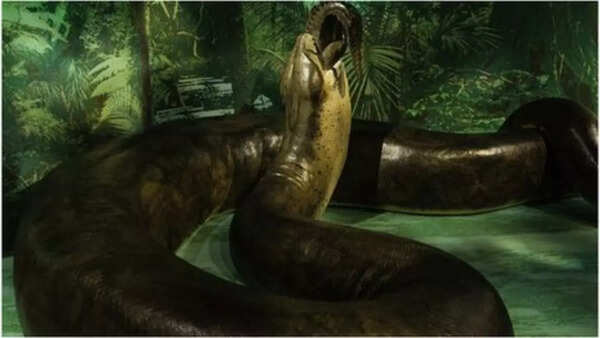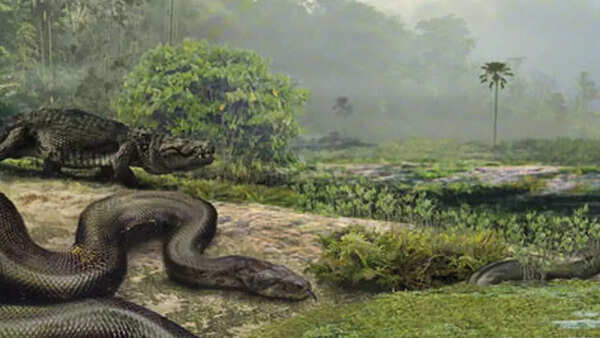What’s bigger than an anaconda? This 58-million-year-old fossil of prehistoric snake in Colombia may have the answer |

In a groundbreaking paleontological discovery, scientists have uncovered fossil remains of a prehistoric snake that challenges everything we know about reptilian evolution. Called Titanoboa cerrejonensis, this extinct serpent lived over 58 million years ago and is now recognised as the largest and heaviest snake ever found. Stretching up to 14 meters in length and weighing over a tonne, Titanoboa dwarfs today’s anaconda and python species. Its discovery in Colombia’s Cerrejón coal mine offers rare insight into ancient ecosystems, tropical climate conditions, and the scale of prehistoric megafauna. This astonishing find reshapes our understanding of prehistoric snakes and their dominance after the dinosaurs.
World’s biggest snake fossil found: Meet Titanoboa, the 58-million-year-old giant
The Titanoboa cerrejonensis is a now-extinct species of snake that thrived during the Paleocene Epoch, a critical period in Earth’s history that followed the extinction of the dinosaurs. What sets Titanoboa apart is not only its enormous size but also the insights it offers into the evolution of reptiles, prehistoric ecosystems, and ancient climates.According to BBC reports, this species was virtually unknown to science until 2009, when fossils were unearthed at the Cerrejón coal mine in northern Colombia. The discovery has since transformed our understanding of reptilian evolution and the tropical environments that emerged in the wake of mass extinction.

Source: BBC
Where and when did Titanoboa live
Titanoboa roamed Earth between 58 and 60 million years ago, during a time of ecological recovery after the dinosaurs vanished. Its remains were found in what was once a humid, swampy rainforest—now the Cerrejón mine. This site has become a treasure trove for paleontologists studying the Paleocene, revealing a rich diversity of early tropical life.The ancient rainforest, teeming with warmth and moisture, offered the perfect environment for cold-blooded animals like Titanoboa to grow to such extraordinary sizes.
Titanoboa: Size and weight
According to scientific estimates, Titanoboa cerrejonensis reached lengths of up to 13–14 meters (42–46 feet)—about the size of a modern school bus—and weighed over one metric ton. In comparison, the green anaconda, often considered the largest living snake today, rarely exceeds 6 meters in length and 250 kg in weight. This makes Titanoboa not only the largest snake in the world but also a true apex predator of its time.

Source: Smithsonian Magazine
Titanoboa hunting strategy: A predator without venom
Unlike venomous snakes, Titanoboa killed its prey using constriction. It would coil around its target whether a mammal, reptile, or fish and squeeze until the animal suffocated. Once its prey was immobilized, the snake would swallow it whole, starting with the head. This mode of predation is similar to how modern boas and pythons hunt, showing that despite its size, Titanoboa’s feeding behaviour followed well-known biological strategies.
Titanoboa diet
Initially, scientists assumed Titanoboa fed on large land mammals. However, further analysis of its jawbones revealed loose teeth—a feature uncommon in meat-eating snakes but typical of aquatic feeders. This surprising anatomical trait indicated that Titanoboa was a semi-aquatic snake, likely residing in rivers and lagoons, feeding primarily on large fish. This also places it in ecological comparison with today’s green anaconda, which exhibits similar behaviour and habitat preference.
Climate clues hidden in Titanoboa’s biology
As a cold-blooded reptile, Titanoboa depended heavily on external heat to regulate its body temperature. Its massive size would have required consistent warmth, suggesting that the climate during the Paleocene was significantly hotter than it is today. Estimates show the average temperature in its habitat was between 86°F and 93°F (30°C–34°C)—a level of heat crucial for sustaining such a giant prehistoric snake.
Why the discovery of Titanoboa matters
The discovery of Titanoboa cerrejonensis is far more than just an awe-inspiring tale of a giant snake. It provides crucial insights into:
- The evolution of reptiles after the extinction of dinosaurs
- The climate conditions that allowed such massive cold-blooded creatures to thrive
- The biodiversity and structure of early tropical ecosystems





